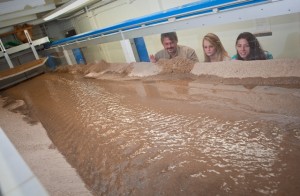 Students aren’t the only ones who benefit from Lafayette’s high-tech science labs. There are villagers in El Convento, Honduras, whose need for clean, running water is hinging on the hydraulics flume laboratory in Van Wickle Hall.
Students aren’t the only ones who benefit from Lafayette’s high-tech science labs. There are villagers in El Convento, Honduras, whose need for clean, running water is hinging on the hydraulics flume laboratory in Van Wickle Hall.
That’s where students in the College’s chapter of Engineers Without Borders are troubleshooting sedimentation problems with the dam they built in El Convento and testing water-collection systems to complete viable designs by the end of next semester. Project leader Carson Gentry ’13 (Stockton, N.J.) says that without the flume, his team could not complete critical work on the Honduras dam project.
“In class, we can only theorize what will happen and calculate the most likely outcomes, but in the case of our dam, we need hands-on testing to fully endorse a proposal,” explains Gentry, a civil engineering major. “In Honduras, we have limited time and resources. We cannot simply try ideas until we find the right fix because the site is hard to reach and our time there is always short.”
Installed in 2001 with a grant from the Keck Foundation, the flume measures two meters wide by nine meters long and is mounted on hydraulic jacks that allow users to change the slope from flat to three percent, a steep gradient for a river. Students can create model rivers in the flume that mimic actual ones. By controlling the flow rate, sediment-delivery rate, and river energy, students study sediment transport, how flow energy affects sediment transport, and the relationships among hydraulics, ripples and dunes, and sedimentary structures.
“If a picture is worth a thousand words, a dynamic physical model is worth a million words,” says Dru Germanoski, Ervin R. VanArtsdalen Professor and head of geology and environmental geosciences. “The flume is just that – a kinematic and dynamic model that shows fluvial processes in action.”
Germanoski uses the flume for his Environmental Geology and Earth Surface Processes courses. In Environmental Geology, students model the Platte River, a naturally high energy river with high rates of sand transport resulting in a fully braided river that is naturally wide and shallow. (A braided river has a network of small channels separated by small, often temporary islands.) The Platte’s natural form and structure makes it crucial to the migratory path of whooping cranes and sandhill cranes, but dams constructed along the river have changed it to narrow and deep, thus removing crane habitat. In Earth Surface Processes, students measure the fluid shear stress — the force that flowing water exerts on a channel bed — by sieving sediment into different grain sizes and adjusting the flume gradient.
Geology major Alexandria Brannick ’12 (Point Pleasant, N.J.) has used the flume in her From Fire to Ice: An Introduction to Geology course taught by Guy Hovis, John H. Markle Professor of Geology, and the Sedimentology course taught by David Sunderlin, assistant professor of geology. Brannick, who plans to pursue a Ph.D. in paleontology, says hands-on experience is especially important in a field like geology.
“It allows us to observe what occurs in natural environments under a more controlled and magnified setting,” she says. “It is one thing to just read about processes in a book, but when we can actually see them in progress, it gives us a new appreciation for what we are learning.”
Sean Murphy ’11 (Stoughton, Mass.) is a geology major in Sunderlin’s Modern and Ancient Depositional Environments course. By using the flume, his class observed sediment transport mechanisms by creating a sand bar migration in a matter of minutes, a process that occurs over a multi-year period in nature.
“The benefit of having the flume is being able to actively observe some of the harder-to-envision concepts,” says Murphy, who plans to attend graduate school. “The ability to imagine a geologic process makes the process easy to understand and explain. The flume shows us some of these processes – we don’t have to imagine them.”
When Maricate Conlon ’11 (Charlotte, N.C.) begins researching fluvial geomorphology and hydrogeology in graduate school, she’ll already have used the flume to simulate sand bar creation in Germanoski’s Hydrogeology course. It’s a great alternative, she says, when there is no nearby field area available to study class concepts.
“It puts the ideas from lecture into practice,” says Conlon, a geology major. “The geology department is constantly looking for new types of equipment to enhance the lab and lecture experience. It sets Lafayette apart that scientific courses are balanced and enhanced with hands-on work.”
